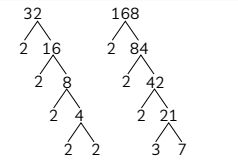Curriculum
⭐ Master Class 10 Maths with 50+ Worksheets, Solutions & Video Explanations
Chapter 1 : Real Numbers
0/2Chapter Notes
0/1Mathematics| Chapter -Real Numbers |
Topic 1 : Prime Factorisation
Prime Numbers : The numbers which have no factors other than 1 and the number itself are called prime numbers.
Smallest Prime No. – 2
Example : 2,3,5,7,41,61
Composite Numbers : The numbers which have atleast one factor other than 1 and the number itself are called composite numbers.
Smallest Composite No. – 4
Example: 4,6,8,9,15,32
Co-Prime Numbers : The set of numbers which don’t have any common factor other than 1 are called co-prime numbers.
Example : (3,16) , (5,8) , ( 15, 32 )
Factor of a Number : If a number divides another number exactly, then the number which divides, is called a factor of that number.
Example : Factor of 6 – > 1,2,3,6
Factor Tree : It is a chain of factors of a number, which is represented in the form of a tree.

Example 1. : Express the number 3825 as a product of its prime factors. (Understand) [NCERT]
Example 2. The exponent of 5 in the prime factorisation of 3750 is:
(a) 3
(b) 4
(c) 5
(d) 6
Example 3. Assertion (A): The prime factors of 3750 are
$ 2 \times 3 \times 5^4 $
Reason (R): Composite numbers are the numbers which have atleast one factor other than 1 and the number itself.
Choose the correct option :
(a) Both assertion (A) and reason (R) are true and reason (R) is the correct explanation of assertion (A).
(b) Both assertion (A) and reason (R) are true and reason $(R)$ is not the correct explanation of assertion (A).
(c) Assertion (A) is true but reason (R) is false.
(d) Assertion (A) is false but reason (R) is true.
Case Based Questions ( CBQs)
Example 4. Teaching Mathematics through activities is a powerful approach that enhances students’ understanding and engagement. Keeping this in mind, Ms. Mukta planned a prime number game for class 5 students. She announces the number 2 in her class and asked the first student to multiply it by a prime number and then pass it to second student. Second student also multiplied it by a prime number and passed it to third student. In this way by multiplying to a prime number, the last student got 173250.
Now, Mukta asked some questions as given below to the students:
(A) What is the least prime number used by students?
(B) How many students are in the class?
OR
(a) What is the highest prime number used by students?
(C) Which prime number has been used maximum times?
————————
HCF AND LCM USING PRIME FACTORISATION
(1) HCF is the product of the smallest power of each common primes of the given numbers. It is also called GCD of the numbers.
(2) LCM is the product of greatest power of each prime factor of the given numbers.
(3) $\mathrm{HCF} \times \mathrm{LCM}=$ Product of two positive integers i.e., for any two positive integers $a$ and $b$,
$ \operatorname{HCF}(a, b) \times \operatorname{LCM}(a, b)=a \times b $
Example 5 . Find the HCF and LCM of the integers 12,15 and 21 by applying prime factorisation method.
Example 6. Given that $\operatorname{HCF}(306,657)=9$, find LCM $(306,657)$.